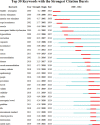Progress and research trends in neurogenic bladder after spinal cord injury bibliometric analysis based on web of science database: An observational study
- PMID: 38875432
- PMCID: PMC11175955
- DOI: 10.1097/MD.0000000000038491
Progress and research trends in neurogenic bladder after spinal cord injury bibliometric analysis based on web of science database: An observational study
Abstract
Neurogenic bladder (NB) is a significant complication that often occurs after spinal cord injury. It results from urinary dysfunction caused by the injury, disrupting the normal neural control of the bladder and urethra. Symptoms of NB can include urinary frequency, urgency, incontinence, and retention, all of which can greatly impact the quality of life of affected individuals. While there are articles and reviews on NB, fewer specifically address NB following spinal cord injury. This study examined 1095 publications from January 1, 2000, to March 27, 2024, in the Web of Science core database using bibliometric software like VOSviewer, CiteSpace, and Bibliometrics. The analysis revealed an increasing trend in the number of publications, with the United States and China leading in research output. Professor Jeremy B. Myers from the University of Utah had the highest number of publications, while the University of Michigan and the University of Pittsburgh were the institutions with the most publications. The journal Neurourology and Urodynamics had the highest number of articles, and common keywords included management, quality of life, and dysfunction, highlighting key areas of focus for scholars.
Copyright © 2024 the Author(s). Published by Wolters Kluwer Health, Inc.
Conflict of interest statement
The authors have no funding and conflicts of interest to disclose.
Figures












Similar articles
-
Survey of spinal cord injury-induced neurogenic bladder studies using the Web of Science.Neural Regen Res. 2012 Aug 15;7(23):1832-9. doi: 10.3969/j.issn.1673-5374.2012.23.010. Neural Regen Res. 2012. PMID: 25624808 Free PMC article.
-
Exploring the Landscape of Hydrogel Therapy for Spinal Cord Injury: A Bibliometric and Visual Analysis (1991-2023).World Neurosurg. 2024 Jun;186:e95-e105. doi: 10.1016/j.wneu.2024.03.048. Epub 2024 Mar 18. World Neurosurg. 2024. PMID: 38508381 Review.
-
Patient Reported Bladder Related Symptoms and Quality of Life after Spinal Cord Injury with Different Bladder Management Strategies.J Urol. 2019 Sep;202(3):574-584. doi: 10.1097/JU.0000000000000270. Epub 2019 Aug 8. J Urol. 2019. PMID: 30958741
-
Bibliometric and visualized analysis of scientific publications on rehabilitation of rotator cuff injury based on web of science.Front Public Health. 2023 Feb 17;11:1064576. doi: 10.3389/fpubh.2023.1064576. eCollection 2023. Front Public Health. 2023. PMID: 36875410 Free PMC article.
-
Trends of spinal tuberculosis research (1994-2015): A bibliometric study.Medicine (Baltimore). 2016 Sep;95(38):e4923. doi: 10.1097/MD.0000000000004923. Medicine (Baltimore). 2016. PMID: 27661044 Free PMC article. Review.
References
-
- Samson G, Cardenas DD. Neurogenic bladder in spinal cord injury. Phys Med Rehabil Clin N Am. 2007;18:255–74, vi. - PubMed
-
- Javeed S, Greenberg JK, Zhang JK, et al. . Association of upper-limb neurological recovery with functional outcomes in high cervical spinal cord injury. J Neurosurg Spine. 2023;39:355–62. - PubMed
-
- Wu YC. Total bladder care for the spinal cord injured patient. Ann Acad Med Singap. 1983;12:387–99. - PubMed
Publication types
MeSH terms
LinkOut - more resources
Full Text Sources
Medical

